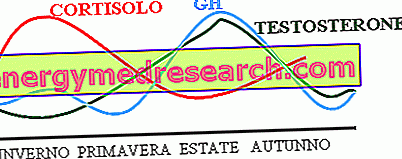Generality
Kidney stones - identified by the medical term "nephrolithiasis" or "renal lithiasis" - are small aggregations of mineral salts that form in the urinary tract.

Sometimes kidney stones are asymptomatic and are discovered by chance during a control radiograph. Other times an acute and violent pain (renal colic) strongly signals their presence.
What are?
Kidney stones are deposits of hard consistency formed by precipitation of the mineral salts contained in the urine (calcium, oxalate, phosphates and uric acid). The formation of a calculation is favored by the increase in the concentration of these electrolytes or by the reduction of the liquid that keeps them in solution (low volume of urine).
When the salts aggregate together they first form crystals, then microcalcols and finally calculations that can reach the size of a golf ball. Precisely because of their shape and chemical composition, kidney stones can move from the place of origin and hinder the flow of urine. This obstacle, in addition to causing intense pain, promotes the development of urinary infections and, if it persists for long periods, increases the possibility of damage to the kidneys, to the point of developing progressive renal failure.
Normally the urine contains substances that prevent the formation of stones, but these compounds are not always present in adequate quantities or perform their function effectively. Today two categories are known: macromolecular (proteic in nature) and micromolecular like citrate or magnesium. Also the mucopolysaccharides, thanks to their colloidal properties, favor the maintenance of salts in solution, removing the formation of kidney stones.
Based on the chemical composition, different types of calculations can be distinguished, each of which requires a different therapeutic approach:
KIDNEY CALCULATIONS, ORIGIN, INCIDENCE AND CLASSIFICATION | ||||
calcic (70-80%) | MIXED (5-10%) | URICA (5-15%) | INFECTIOUS (10-15%) | cistinic (1-2%) |
Calcium oxalate (60%) Calcium oxalate and calcium phosphate (30%) Calcium phosphate (10%) | Calcium oxalate, uric acid and calcium phosphate (30%) | Uric acid, calcium urate | Struvite (phosphate - ammonium - magnesium) Struvite and apatite carbonate or ammonium urate Calcium phosphate | cystine |
To these data must be added the calculations of rare origin (1-2% incidence) that may be caused by the accumulation of xanthine, hypoxanthine, cholesterol, fatty acids or 2, 8-hydroxydenin | ||||
Risk factors
Kidney stones are quite common in the population as they affect on average about 3% of people. Males between the ages of twenty and forty are particularly at risk. In this age group, due to the simultaneous presence of more risk factors, the incidence of the disease exceeds 15%.
The causes of the origin of the calculosis have not yet been completely clarified, even if some predisposing factors significantly increase the probability that calculations are formed:
- sex: males are three times more likely than women to develop urinary tract stones (the higher concentration of citrate in female urine, closely related to the estrogenic rate, would explain this lower incidence of the problem in the fairer sex)
- poor liquid intake: a limited flow of urine favors the stagnation, therefore the precipitation of the salts contained in them
- dehydration due to increased fluid loss (diarrhea, hyperhidrosis etc.
- age: kidney stones form mainly between the ages of twenty and forty
- acidity of urine: urinary pH less than 5 (as regards some very specific types of calcium, such as those of cystine, xanthines and uric acid)
- family history of kidney stones: this is the case, for example, of stones of cystinic origin in which, due to a congenital defect of the kidney, a scarcely soluble amino acid in the urine (cystine) precipitates forming crystals
- chronic urinary tract infections
abuse of certain medicines or saline and vitamin supplements
- hyperthyroidism (catabolic effect on bone) and hyperparathyroidism (serum calcium increase)
incongruous diet
- ethnicity: higher incidence of kidney stones in the white and Asian race
- climate (during the hot summer period the greater evaporation, if not replenished by an adequate supply of liquids increases the concentration of the urine and the precipitation of the calculations)
Kidney stones - Video: Causes and Risk Factors
X Problems with video playback? Reload from YouTube Go to Video Page Go to Wellness Destination Watch the video on youtube



